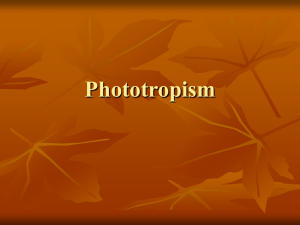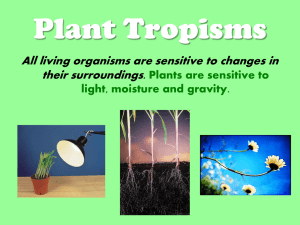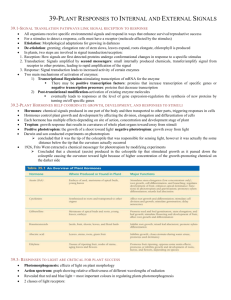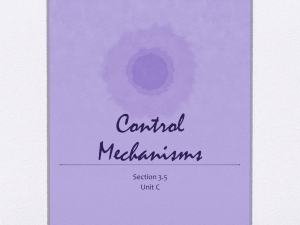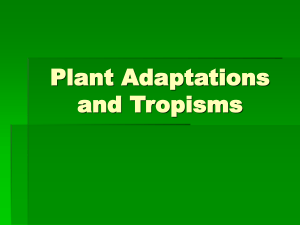Phototropism Lab: Plant Response to Light
advertisement
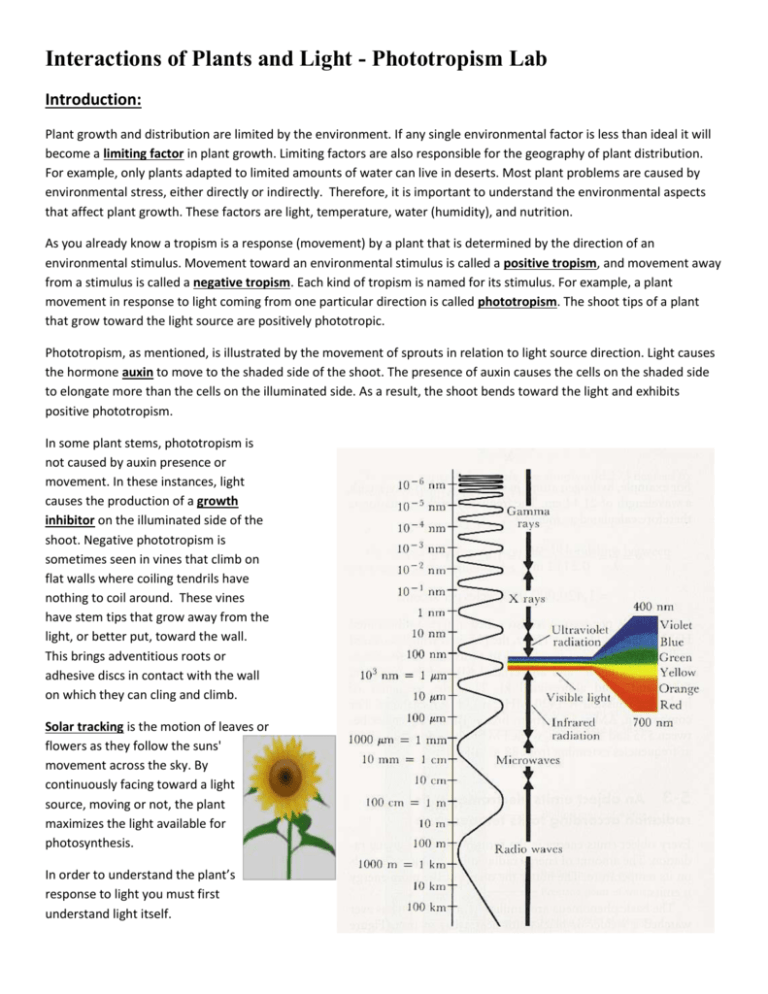
Interactions of Plants and Light - Phototropism Lab Introduction: Plant growth and distribution are limited by the environment. If any single environmental factor is less than ideal it will become a limiting factor in plant growth. Limiting factors are also responsible for the geography of plant distribution. For example, only plants adapted to limited amounts of water can live in deserts. Most plant problems are caused by environmental stress, either directly or indirectly. Therefore, it is important to understand the environmental aspects that affect plant growth. These factors are light, temperature, water (humidity), and nutrition. As you already know a tropism is a response (movement) by a plant that is determined by the direction of an environmental stimulus. Movement toward an environmental stimulus is called a positive tropism, and movement away from a stimulus is called a negative tropism. Each kind of tropism is named for its stimulus. For example, a plant movement in response to light coming from one particular direction is called phototropism. The shoot tips of a plant that grow toward the light source are positively phototropic. Phototropism, as mentioned, is illustrated by the movement of sprouts in relation to light source direction. Light causes the hormone auxin to move to the shaded side of the shoot. The presence of auxin causes the cells on the shaded side to elongate more than the cells on the illuminated side. As a result, the shoot bends toward the light and exhibits positive phototropism. In some plant stems, phototropism is not caused by auxin presence or movement. In these instances, light causes the production of a growth inhibitor on the illuminated side of the shoot. Negative phototropism is sometimes seen in vines that climb on flat walls where coiling tendrils have nothing to coil around. These vines have stem tips that grow away from the light, or better put, toward the wall. This brings adventitious roots or adhesive discs in contact with the wall on which they can cling and climb. Solar tracking is the motion of leaves or flowers as they follow the suns' movement across the sky. By continuously facing toward a light source, moving or not, the plant maximizes the light available for photosynthesis. In order to understand the plant’s response to light you must first understand light itself. Light has three principal characteristics that affect plant growth: quantity, quality, and duration. Light quantity refers to the intensity or concentration of sunlight and varies with the season of the year. The maximum is present in the summer and the minimum in winter. The more sunlight a plant receives (up to a point), the better capacity it has to produce plant food through photosynthesis. As the sunlight quantity decreases the photosynthetic process decreases. Light quantity can be decreased in a garden or greenhouse by using shade-cloth or shading paint above the plants. It can be increased by surrounding plants with white or reflective material or supplemental lights. Light quality refers to the color or wavelength reaching the plant surface. Sunlight can be broken up by a prism into respective colors of red, orange, yellow, green, blue, indigo, and violet. On a rainy day, raindrops act as tiny prisms and break the sunlight into these colors producing a rainbow. Red and blue light have the greatest effect on plant growth. Green light is least effective to plants as most plants reflect green light and absorb very little. It is this reflected light that makes them appear green. Blue light is primarily responsible for vegetative growth or leaf growth. Red light when combined with blue light, encourages flowering in plants. Fluorescent or cool-white light is high in the blue range of light quality and is used to encourage leafy growth. These lights are excellent for starting seedlings. Incandescent light is high in the red or orange range but generally produces too much heat to be a valuable light source. Fluorescent "grow" lights have a mixture of red and blue colors that attempts to imitate sunlight as closely as possible. They are costly and generally not of any greater value than regular fluorescent lights. The third characteristic of light is light duration. Photoperiod refers to the amount of time that a plant is exposed to sunlight. When the concept of photoperiod was first recognized it was thought that the length of periods of light triggered flowering. The various categories of response were named according to the light length (i.e., short-day and long-day). It was then discovered that it is not the length of the light period but the length of uninterrupted dark periods that is critical to floral development. The ability of many plants to flower is controlled by photoperiod. Plants can be classified into three categories, depending upon their flowering response to the duration of darkness. These are short-day, long-day, or day-neutral plants. Short-day, (long nights) plants form their flowers only when the day length is less than about 12 hours in duration. Short-day plants include many spring and fall flowering plants such as chrysanthemum and poinsettia. Long-day, (short nights) plants form flowers only when day lengths exceed 12 hours. They include almost all of the summer-flowering plants, as well as many vegetables including beet, radish, lettuce, spinach, and potato. Day-neutral plants form flowers regardless of day length. Some plants do not really fit into any category but may be responsive to combinations of day lengths. The petunia will flower regardless of day length, but flowers earlier and more profusely under long daylight. Since chrysanthemums flower under the short-day conditions of spring or fall the method for manipulating the plant into experiencing short days is very simple. If long days are predominant, a black plastic sheet is drawn over the chrysanthemum for 12 hours daily to block out light until flower buds are initiated. To bring a long-day plant into flower when sunlight is not present longer than 12 hours artificial light is added until flower buds are initiated. Materials: 4 shoe boxes 4 colors of cellophane (red, blue, green, and clear) 4 square flower pots containing radish seedlings 2 lamps Procedure: In this experiment you will expose radish seedlings to 3 different colors of light for a 24 hour period and record the impact of phototropism. Pre-lab Setup: Step 1: Cut out one end of each of the four shoeboxes and cover the open hole of each shoebox with a different color of cellophane (red, blue, green, and clear). Procedure Day 1: Step 2: Place a light source on one end of your lab table. Step 3: Place each of the four shoeboxes on the opposite end of the lab table with the cellophane covered end facing the light source. Step 4: Place one square pot of radish seedlings in each of the four shoeboxes Create a Hypothesis: In the space below, write a hypothesis regarding this lab procedure. Be sure to write your hypothesis as an “If (independent variable) then (dependent variable)” statement. Be specific!! Name the independent variable(s) of this experiment: Name the dependant variable(s) of this experiment: Draw a sketch of your experimental set up. Label the parts of your experiment including the control. Analysis Questions: 1. Define limiting factor. List an example of a limiting factor that may affect plants and explain specifically why this factor may be limiting. 2. Define tropism and list three examples of tropisms. 3. Define Phototropism. 4. Define Positive Tropism. Give an example of a positive phototropism. 5. Define Negative Tropism. Give an example of a negative phototropism. 6. What is auxin? 7. How does auxin affect a plant during phototropism? 8. How does growth inhibitor affect a plant during phototropism? 9. What is solar tracking? 10. How does solar tracking affect the rate of photosynthesis in a plant? 11. List the seven colors of the light spectrum. 12. List the individual wavelengths of each of the seven colors of the light spectrum. 13. Explain light quantity. 14. How would light quantity be decreased in a garden or greenhouse? 15. How would light quantity be increased in a garden or greenhouse? 16. Explain light quality. 17. True or False: Most plants are green because they absorb green light. 18. Which two colors of the light spectrum have the greatest effect on plant growth? 19. Which color of the light spectrum has the least effect on plant growth? 20. Based on your previous answers, which color or colors of cellophane will result in the most movement towards light during your lab? 21. Explain light duration. 22. Define photoperiod. 23. During which of the four seasons is the photoperiod the longest? 24. Define short-day plants, long-day plants, and day-neutral plants and give an example of each type of plant. Procedure Day 2: Step 5: Carefully record your results. Pay specific attention to how each of the different colors of light affected the phototropism of the radish seedlings. After your group has collected its data you need to answer the following questions. 1. Which characteristic of light was the shoe box lab testing (light quantity, light quality, or light duration)? 2. Consider a second lab in which two plants were exposed to 12 hours of continuous white light. The first plant was exposed to a 40 watt bulb while the second was exposed to a 100 watt bulb. What characteristic of light was being tested in this lab (light quantity, light quality, or light duration)? 3. In which flowerpot were the radish seedlings stems the least curved? 4. In which flowerpot were the radish seedlings stems the most curved? 5. In what direction were the stems curved (towards or away from the light)? 6. What effect if any did the red, blue, green, and clear cellophane have on the direction of growth? 7. Are your results different than you expected? For example, did you expect the plants growing behind green cellophane to be least affected by phototropism, but your results show them to be the most affected?) 8. Remembering your color spectrums why are plants like radishes green? (Your answer should include the words absorb and reflect) 9. Remembering your color spectrums why is green cellophane green? (Your answer should include the words absorb and reflect) 10. Therefore, what colors are allowed to pass through green cellophane? Conclusion: In the space below, state whether your data supports or refutes your hypothesis. Include any sources of error. Be sure to use data in your conclusion to support your conclusion. Making Modifications: In the space below explain how you could alter this experiment in order to obtain better results Result
